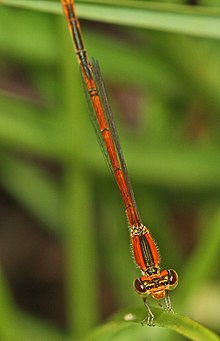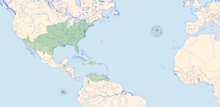Enigmatic pitch dragonfly
| Enigmatic pitch dragonfly | ||||||||||||
|---|---|---|---|---|---|---|---|---|---|---|---|---|

Enigmatic pitch dragonfly, male |
||||||||||||
| Systematics | ||||||||||||
|
||||||||||||
| Scientific name | ||||||||||||
| Ischnura hastata | ||||||||||||
| ( Say , 1840) |
The mysterious pitch dragonfly ( Ischnura hastata ) is a species of dragonfly from the family of the slender dragonfly (Coenagrionidae), which is widespread in North and Central America. The puzzling pitch dragonfly is special in several ways. On the one hand, it is the only North American species that reproduces regularly in Europe, but here reproduction takes place exclusively parthenogenetically . Parthenogenetic reproduction is not known from any other dragonfly species. The enigmatic pitch dragonfly is also the only dragonfly species in which the pterostigma of the forewing in the male is not located on the edge of the wing, but rather is indented inside. Also within the genus it is unusual due to the lack of female color variants and a not completely blackened male abdomen .
features
With a body length of 21 to 27 millimeters and a length of the hind wings of 9 to 15 millimeters, the mysterious pitch dragonfly is a very small species of slender dragonfly. As is common with pitch dragonflies , males and females show pronounced sexual dimorphism .
The males are very conspicuous due to their strong yellow basic color, the eyes are yellow in front, turn green towards the back, on top they look like covered by a black cap. The blue-green post-eyepiece spots are very small and not connected by a line. The thorax is greenish in color, the light-colored ante-humeral stripes are narrow and the humeral stripes wide. The abdomen is yellow, only the first two abdominal segments show a greenish hue as a transition to the thorax. Segments one and two are colored black on the upper side, at the joints of segments three to six there is a narrow black ring, which is preceded by spear-shaped spots on both sides; these can also merge on the sixth segment. Segments seven to ten are completely without black markings, in lower latitudes the seventh segment can sometimes be colored black. In the side view of the tenth segment, there is an unusual rod-shaped projection pointing upwards.
The orange pterostigma of the forewings is unique because it is only in this type of dragonfly that it has moved away from the edge of the wing. The wing mark is separated from the surrounding cells by a thickened white vein, the shape is rather rounded. The black stigmata of the hind wings are normal and about half the size of those of the forewings. The pterostigmata of the females are normal.
In the juvenile form, the females are brightly red-orange all over their body and have conspicuous orange postocular spots on top of the complex eyes , which are connected by a line. The central stripe is black, the humeral stripe only weakly or not at all. The abdomen is orange, the abdominal segments six to nine are colored continuously black on the upper side, sometimes there is also a color on the fifth segment. With the onset of sexual maturity, the eyes of the females turn a dull greenish color with a brown cap, banded in the middle by a horizontal thin black stripe. All previously bright upper surfaces of the abdominal segments darken and the side surfaces of the thorax turn gray on the upper side and white on the lower side, later greenish everywhere. As it matures, the abdomen becomes greyish with wax, often banded in a light dark gray, but never so dense that the drawing below is covered. In more humid areas the wax tires turn a dull blackish color, whereas in drier areas it turns pale gray. The lack of different female color variants is unusual for the pitch dragonfly genus.
Similar species
The male adults are unmistakable due to their conspicuous abdominal drawing, but especially due to the indented pterostigma of the forewings. Immature females of the mysterious pitch dragonfly differ from immature females of Ischnura verticalis by the poorly developed or completely absent humeral stripe , from the females of Ischnura prognata and Ischnura ramburii by their smaller size and the greater proportion of orange at the base of the abdomen, which is the case with I. ramburii can only be found on the first and second abdominal segment and in the case of I. prognata only on the third and fourth segment. Ischnura hastata is also characterized by a wider median than I. prognata .
The wax tires of mature females of the enigmatic pitch dragonfly never cover the glossy black median stripe of the thorax, but the humeral stripe is covered and so, if it is present at all, cannot be seen. This makes it possible to distinguish the mature females of I. verticalis and Ischnura posita , in which the median stripe is covered, while the humeral stripe, on the other hand, can usually be seen clearly below the tire. Although significantly smaller, I. hastata at one point of maturation with a dull orange-olive-colored thorax can be confused with the then similar mature heterochromic form of I. ramburii . However, this never forms a wax tire on the abdomen and often has bright blue postocular spots.
There is also a possibility of confusion with the little pitch dragonfly ( Ischnura pumilio ), but this is significantly larger than the enigmatic pitch dragonfly and the first two abdominal segments are without drawing, while the first four segments of I. hastata remain light. During the ripening process, the little pitch dragonfly turns blue or sometimes green, stages in which both species are olive-gray can be confused, but the little pitch dragonfly never develops a wax ring. The prothorax is a reliable way of distinguishing it, the posterior margin of which appears clearly rounded in I. pumilio and flattened in I. hastata .
distribution
The distribution area of the enigmatic pitch dragonfly extends in the northeast from Wisconsin , southern Ontario and Maine over the rather sparsely populated southwest and the southern Great Plains , southern California and northern parts of Mexico over the West Indies and Bermuda to Venezuela . Occasionally there is large-scale settlement north of the usual distribution area, possibly it is a question of populations that grow and shrink again with climatic conditions.
As a pioneer species that is often swirled in high layers of air, populations can also be found on the remote archipelagos of the Galápagos Islands - here it is the only species of dragonfly that occurs - and the Azores , where Ischnura hastata is the most common dragonfly species and is only associated with the small pitch dragonfly is. Probably all islands of the Azores group are settled. Occasionally specimens appear on the coast of the Eastern Atlantic.
The habitat of the enigmatic pitch dragonfly are the edges of ponds and lakes that are densely overgrown with grass and sedges. Temporary ponds with similar vegetation are also accepted as a pioneer species, especially in the southern part of the distribution area, and large numbers of upland moors in other areas . In the Azores, almost every pond overgrown with spawning herbs and rushes is inhabited.
Way of life
Ischnura hastata can become very common in suitable habitats around ponds with dense vegetation . Mating with both mature and immature females takes place throughout the day and can continue until after dusk. The mating is rarely observed, however, probably because the females normally only mate once and thus fertilize all of their eggs. The laying of eggs can also be observed far less frequently than with other pitch dragonfly species. The females lay the eggs alone, unaccompanied by the males, in upright or flowing leaves and stems of grass, water lilies or peat moss .
The flight time of the adults differs with the distribution. At the northeastern edge of the range it extends from July to September, in Maine Ischnura hastata is only found in August. More southerly, in Kentucky the flight time extends from May to October, in California it begins in March, in Louisiana in February and lasts until November. I. hastata flies year-round in Texas , Florida and all areas further south . The flight time in the Azores ranges from late May to early August.
Parthenogenic reproduction in the Azores
The isolated occurrence of the enigmatic pitch dragonfly in the Azores is a specialty , as this population only reproduces parthenogenetically . In all generations, only females develop who lay eggs without first mating. Only females hatch from the therefore unfertilised eggs. Parthenogenesis has been proven in many insect species, but only known from this single population in dragonflies. The populations of Ischnura hastata on the American double continent reproduce only normally. A bacterial infection in invertebrates is often responsible for parthenogenesis, but experiments with antibiotics have not yet been able to confirm this for the puzzling pitch dragonfly. It was not until 1990 that the Azorean population of Ischnura hastata could be correctly assigned, although records suggest that it has been around for at least a century.
swell
literature
- John C. Abbott: Damselflies of Texas: a field guide , University of Texas Press, Austin 2011, ISBN 978-0-292-71449-6 .
- Klaas-Douwe B. Dijkstra: Field Guide to the Dragonflies of Britain and Europe . British Wildlife Publishing, Gillingham 2006, ISBN 0-953139948 .
- Dennis Paulson: Dragonflies and Damselflies of the East, Princeton Field Guides , Princeton University Press, New Jersey 2011, ISBN 978-0-691-12283-0 .
- Dennis Paulson: Dragonflies and Damselflies of the West, Princeton Field Guides , Princeton University Press, New Jersey 2000, ISBN 978-0-691-12281-6 .
Individual evidence
- ↑ a b c d e f g h i j Dennis Paulson: Citrine Forktail Ischnura hastata. In Dragonflies and Damselflies of the East , pp. 134-135.
- ↑ a b c d e f g Reinhard Jödicke: Ischnura hastata (Say, 1839). In Dijkstra: Field Guide to the Dragonflies of Britain and Europe , p. 100.
- ↑ a b c d John C. Abbott: Citrine Forktail. In Damselflies of Texas , pp. 216-217.
- ↑ Dennis Paulson: Citrine Forktail Ischnura hastata. In Dragonflies and Damselflies of the West , pp. 125-126.
- ↑ Distribution Summary of North American Zygoptera ( Memento of the original from March 4, 2016 in the Internet Archive ) Info: The archive link was inserted automatically and has not yet been checked. Please check the original and archive link according to the instructions and then remove this notice. Posted by Bill Mauffray and Lyndia Beckenbach, July 1998, compiled from James George Needham, Minter Jackson Westfall, Michael L. May: Dragonflies of North America . Smithsonian Institution Press, 1996; ISBN 0-945417-94-2 . Update March 29, 2012. Retrieved April 4, 2012
Web links
- Citrine Forktail Ischnura hastata on www.stephencresswell.com, with pictures


